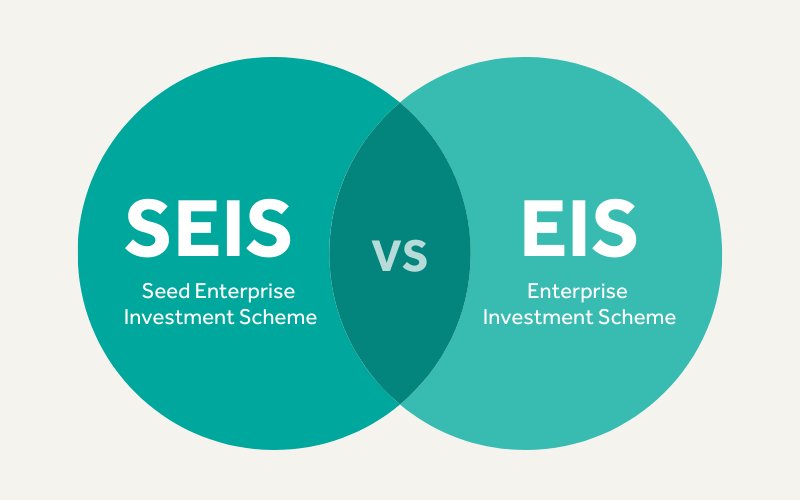
Entrepreneurs, innovators, and fearless startup founders like you are essential to the UK’s economic and technological future. The UK government knows that, and that’s why it offers a wide variety of Venture capital and Collective Investment incentives to encourage private investors to take the risk of investing in early-stage companies like yours.
According to figures released by the UK Business Angels Association, 90% of angel investors have invested through either SEIS or EIS, and 80% of the total investments in angel portfolios are SEIS or EIS.
The two most popular incentives are the Seed Enterprise Investment Scheme (SEIS) and Enterprise Investment Scheme (EIS). These schemes share many similarities in that they both grant investors considerable tax breaks for supporting early-stage founders, but they have some essential differences.
It’s crucial that every investable entrepreneur understands those differences, so you’ll know how to make your investment opportunity as enticing as possible from the first pitch meeting.
The key differences between SEIS and EIS

SEIS was established in 2012 and focuses on very early-stage startups. Private individuals can invest up to £100k per tax year and receive a 50% tax break up to the value invested in return. They’ll also be allowed a capital gains tax exemption on any profits they make if they sell their shares in the company after three years.
Related: Raising Pre-seed Investment: How to Prove Your Concept to Investors
EIS was established in 1992 and focuses on medium-sized startups. Private individuals can invest up to £1m per tax year and receive a 30% tax break on the value invested in return. Like SEIS, they’ll also benefit from a capital gains tax exemption on any profits they make if they sell their shares in the company after three years.
Private investors in SEIS and EIS don’t have to pay inheritance tax on shares they’ve held for at least two years. Also, if they end up selling their shares at a loss, they’ll be able to offset that loss against their capital gains tax.
Why is SEIS/EIS so popular amongst UK investors?

Put simply, the schemes massively reduce the investors’ risk.
Under the SEIS scheme, for every £1,000 invested, an investor would receive £500 off their tax bill, meaning that their investment has cost them, in effect, £500, but they receive £1,000 worth of shares in the company, and the founders receive £1,000 in their bank account.
They also get to keep 100% of the return from the shares upon exit, as there is no capital gains tax.
What’s more, if the business they invested in was to fail, they’d get 45% loss relief on the money at risk in the investment. In this example, that’s £500. So, in the event of a failure, they would get £225 off a future tax bill.
This means that for every £1,000 invested under the SEIS scheme, an investor has just £275 at risk.
It’s a pretty sweet deal, and the main reason London is the centre of the start-up funding ecosystem across Europe. There is more money invested annually in London than in the next 5 major start-up centres in Europe combined.
Is your startup eligible for SEIS or EIS?

Most startups will be, but a small number aren’t.
Your company needs to meet several conditions before your investors can claim either SEIS or EIS relief. For example, if you’re a single company, you must exist for the purposes of carrying on a qualifying trade. If your company is considered ‘non-trading’ under the government guidelines, or if your trade is excluded from the SEIS and EIS schemes entirely, your investors won’t be eligible for either of these incentives.
What are considered ‘excluded trades’ under the schemes?

Excluded trades currently include companies that deal in:
- land, commodities, futures, or shares
- banking, insurance, moneylending, or leasing
- receive royalties or licence fees
- provide legal or accountancy services
- property development
- farming, forestry, or market gardening
- produce coal or steel or are involved in energy generation activities.
However, it’s important to remember that a company will only be excluded under SEIS and EIS if a ‘substantial’ element (+20%) of its trade activity consists of the excluded activity.
You’ll find the complete HMRC guidance here.
What other requirements must your company meet before your investors can claim SEIS/EIS?
SEIS
Your company will be eligible for the SEIS scheme if it:
… is established in the UK.
… carries out a qualifying trade.
… isn’t trading on a recognised stock exchange at the time of the share issue.
… doesn’t hold gross assets over £200k when the shares are issued.
… is not a member of a partnership.
… has less than 25 full-time equivalent employees when the shares are issued.
… hasn’t previously received investment through the EIS or a venture capital trust.
There are other conditions as well. You’ll find a complete breakdown of them here.
EIS
Your company will be eligible for EIS if it:
… has a permanent establishment in the UK.
… carries out a qualifying trade.
… isn’t trading on a recognised stock exchange at the time of the share issue and does not plan to do so.
… doesn’t hold gross assets worth more than £15m before any shares are issued and not more than £16m immediately afterwards.
… has less than 250 full-time equivalent employees when the shares are issued.
You’ll find a complete breakdown of all the qualifying conditions here.
A few other points to consider
- You don’t need to be a UK company to raise SEIS or EIS, so long as you have a UK branch or subsidiary that passes the HMRC’s ‘UK permanent establishment test’.
- Although it’s not widely known, investors can get Liquidation Preference on SEIS/EIS shares. Liquidation Preference is a right that’s frequently given to investors via Preference shares in venture capital rounds but isn’t compatible with SEIS/EIS. However, it is possible to work around that incompatibility by, in essence, giving your investors a different class of Ordinary shares to the shares the founders receive. It’s a complicated process that needs to be set up very carefully, but it can be done with the right legal advice.
- EIS can last longer than seven years, so long as your company has raised some EIS in the first seven years of trading. The provisos to this are that you cannot continue raising EIS after the HMRC’s limit of £12m has been reached, and you can raise no more than £5m in any single 12-month period.
- If your company is beyond the EIS time limit, offering a new product or service will be considered ‘resetting the timer’ by HMRC.
- Founders can repay personal loans they’ve made to the business with SEIS investment (but not EIS).
- Under certain conditions, founders can repay 3rd party loans with SEIS (but not EIS).
- If you’re a tech startup, you might qualify as a ‘Knowledge Intensive Company’ and have a special SEIS/EIS status. A lot of UK tech startups don’t realise they’re eligible for this initiative, so it’s well worth checking out if you meet the government’s criteria. You can find out more information here.
How much can a company raise in SEIS or EIS funding?
SEIS: a maximum of £150k.
EIS: a maximum of £12m.
But, if your company has received any de minimis state aid in the previous three years, that cost will count towards the limit for investment, so you will probably not be eligible to receive the total amount.
How much can an individual investor invest under SEIS or EIS?
SEIS: a maximum of £100k per tax year.
EIS: a maximum of £1m per tax year.
Shares issued under both schemes must be Ordinary shares, with no preferential rights attached.
In addition, any individual investing under SEIS or EIS must not hold more than 30% of the company’s overall shares, nor can they be an employee or Director (before their shares are issued) of the company. However, an investor can be appointed as a Director after their shares have been issued.
What can SEIS and EIS investment be used for?
SEIS and EIS investment funds must be used solely to promote the growth and development of the company, i.e. Hiring new employees, developing the product, and marketing the product.
Most investors will want advance assurance that your startup is eligible for SEIS/EIS.
To secure that assurance, you must apply for advance assurance to HMRC before you begin offering investors SEIS or EIS investment opportunities. HMRC will want to see your business plan and 3-year financial forecast and the details of at least one proposed investor. There are other requirements you’ll have to meet too. If your application is correct and HMRC has no follow-up questions, it generally takes between two to three weeks for HMRC to approve an advanced assurance application.
Our partners at SeedLegals are the best people to approach for support in applying for SEIS/EIS advanced assurance.
What must you do after your funding round has closed?
Once your funding round is closed, and you’ve issued share certificates to your investors, you must submit a SEIS1 and/or EIS1 compliance statement to HMRC before your investors will be granted tax relief. If HMRC is satisfied, they will provide your investors with a unique investment reference number, allowing you to issue them with SEIS3/EIS3 certificates so they can claim their tax relief. Note: it is the investor’s responsibility to claim back their tax relief when they complete their tax return.
Investigating whether you’re eligible for SEIS, EIS, or any of the other government incentives available to startups is something every investable entrepreneur must do. The government has made these provisions available to help smooth your funding journey and give your investment-raising efforts the very best chance of success, so don’t miss out on the opportunity.
Anything you can offer potential investors that will sweeten your deal is well worth the time it takes to get all the advance assurance information that HMRC needs together. If you’ve followed our investable entrepreneur’s blueprint, you should already have most, if not all, of that information at your fingertips, anyway.
You’ll find that blueprint in James Church’s best-selling book, ‘Investable Entrepreneur’, and you can download a free copy of it here.

James Church
Author of Investable Entrepreneur. #1 Amazon Best Seller. | International Speaker | Co-founder of Robot Mascot
